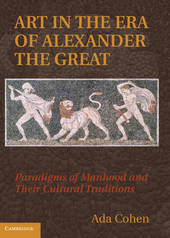
|
Art in the Era of Alexander the Great: Paradigms of Manhood and their Cultural Traditions
Hardback
Main Details
| Title |
Art in the Era of Alexander the Great: Paradigms of Manhood and their Cultural Traditions
|
| Authors and Contributors |
By (author) Ada Cohen
|
| Physical Properties |
| Format:Hardback | | Pages:422 | | Dimensions(mm): Height 261,Width 187 |
|
| Category/Genre | Ancient and classical art BCE to c 500 CE |
|---|
| ISBN/Barcode |
9780521769044
|
| Classifications | Dewey:709.38 |
|---|
| Audience | | Postgraduate, Research & Scholarly | |
|---|
| Illustrations |
11 Plates, color; 134 Halftones, unspecified
|
|
Publishing Details |
| Publisher |
Cambridge University Press
|
| Imprint |
Cambridge University Press
|
| Publication Date |
30 August 2010 |
| Publication Country |
United Kingdom
|
Description
In this book, Ada Cohen focuses on art produced in Macedonia during the late Classical and early Hellenistic period, which coincides with the reigns of Philip II, his famous son Alexander the Great, and their immediate successors. Although inspired by traditional Greek themes and ideals, this body of artwork articulated specifically Macedonian aspirations. Cohen focuses on three key 'masculine' themes - warfare, hunting, and abduction of women - exploring their visual and conceptual interconnections. She demonstrates their preoccupation with the visual celebration of violence and studies the analogies they draw among the ideological categories of 'enemy', 'animal', and 'woman'. Simultaneously historical and thematic, Cohen's text is structured around select paintings and mosaics from northern Greek sites, such as Pella and Vergina, and from both secular and funerary contexts. She also examines monuments from other ancient contexts and in other media to illuminate specific questions of style, theme, and meaning.
Author Biography
Ada Cohen is Associate Professor of Art History at Dartmouth College. She is the author of The Alexander Mosaic: Stories of Victory and Defeat and co-editor of Constructions of Childhood in Ancient Greece and Italy and Assyrian Reliefs from the Palace of Ashurnasirpal II: A Cultural Biography.
|